BSBINN801 Leading Innovation: Business Management Development
VerifiedAdded on 2022/09/07
|7
|2212
|14
Report
AI Summary
This report explores the concept of innovation within a business context, focusing on its significance and practical application. It delves into various innovation theories, including disruptive, sustaining, radical, and incremental innovation, highlighting their impact on customer engagement and market share. The report also examines the role of leadership styles, particularly democratic and laissez-faire approaches, in fostering innovation, contrasting them with autocratic styles. Internal and external factors influencing organizational innovation, such as career development programs and competitive pressures, are discussed, along with potential risks and challenges. The report further identifies key elements driving innovation, including organizational culture, structure, and processes, as well as enablers like human resources, mindset, and knowledge management. Barriers to innovation, such as lack of leadership, resources, and collaboration, are addressed, and the benefits of introducing change management are highlighted. The report concludes by emphasizing the importance of sustainable innovation for competitive advantage and the need for open communication and risk tolerance within organizations. Desklib provides a platform for students to access this and many other solved assignments to aid in their studies.
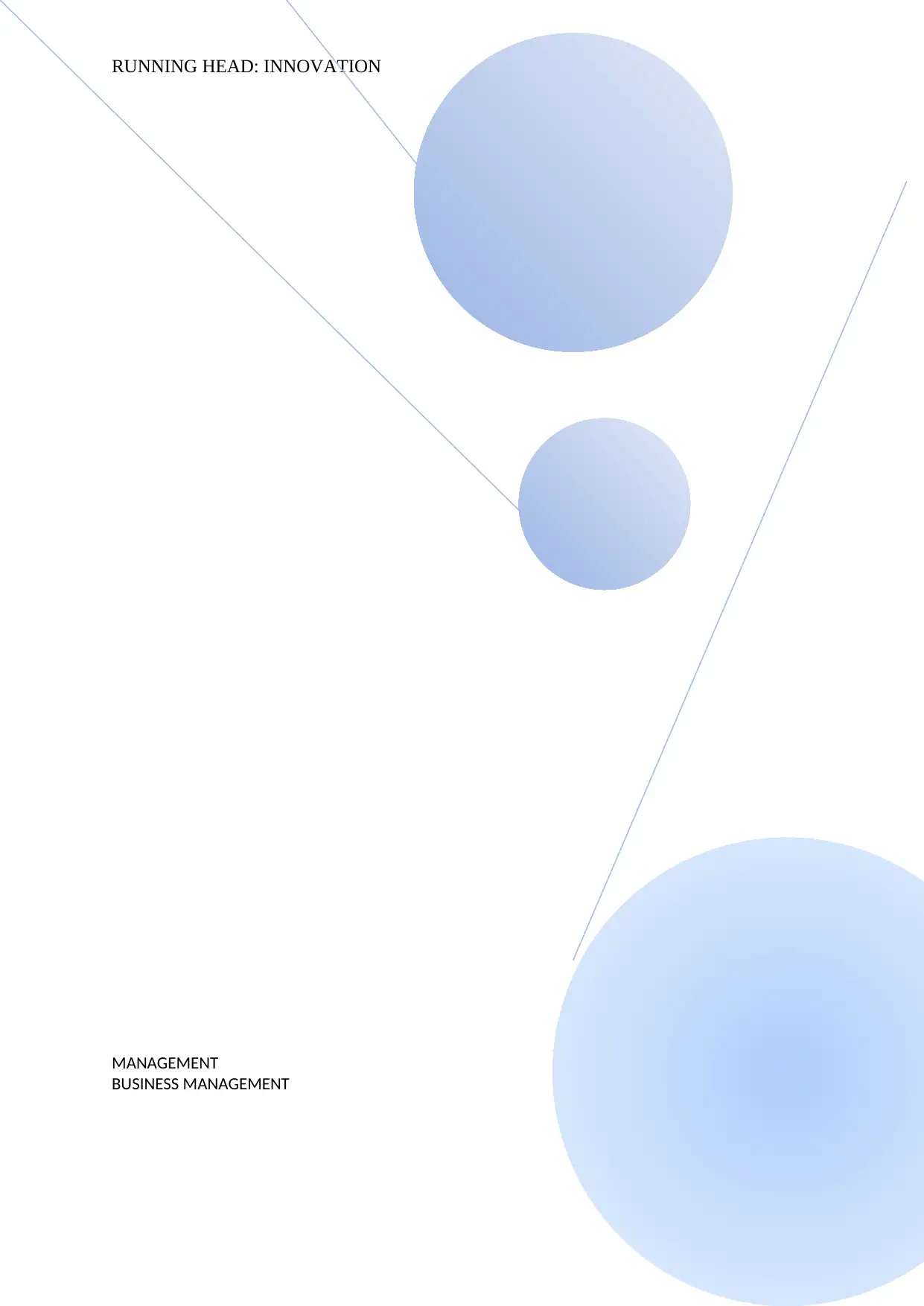
RUNNING HEAD: INNOVATION
MANAGEMENT
BUSINESS MANAGEMENT
MANAGEMENT
BUSINESS MANAGEMENT
Paraphrase This Document
Need a fresh take? Get an instant paraphrase of this document with our AI Paraphraser
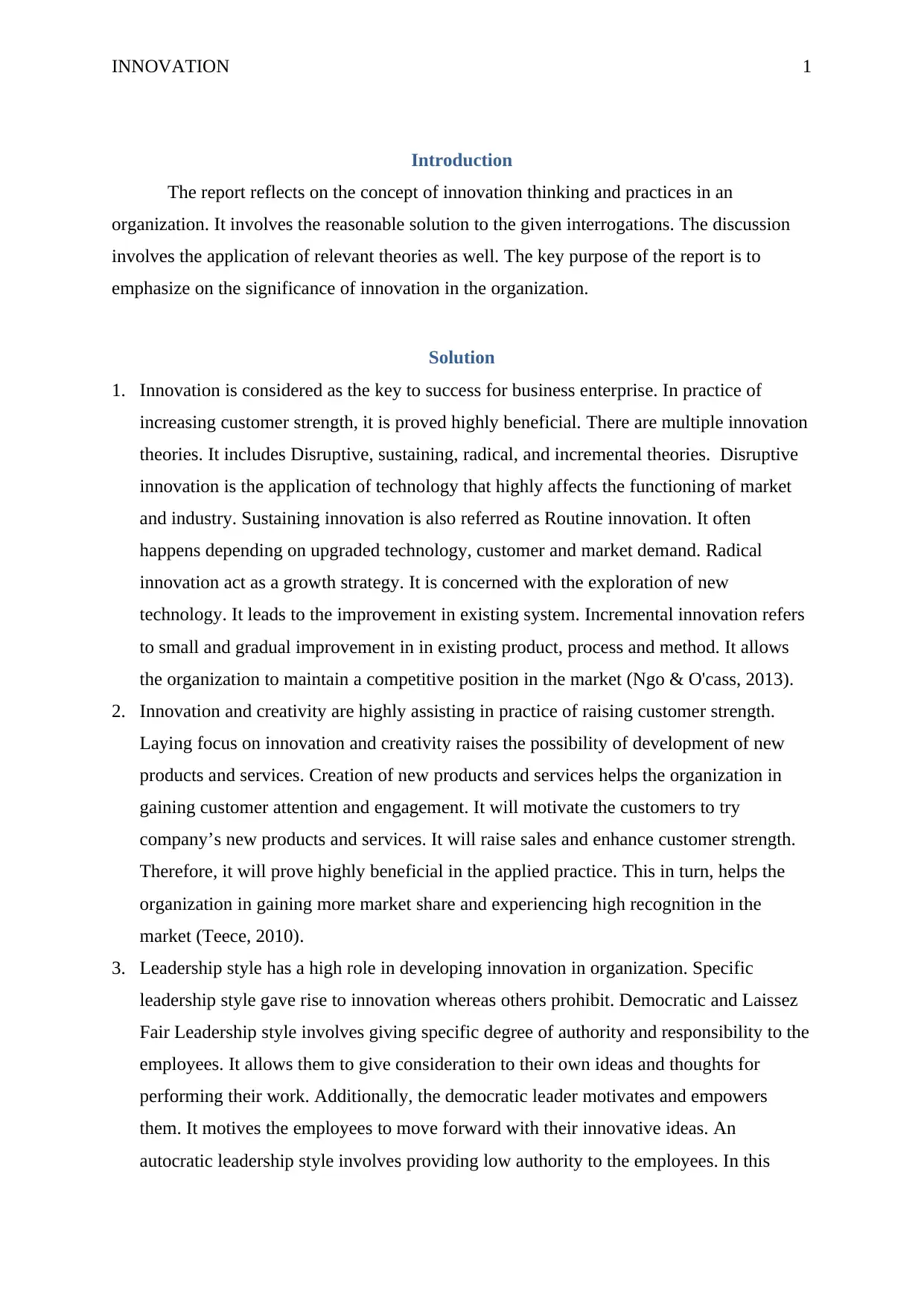
INNOVATION 1
Introduction
The report reflects on the concept of innovation thinking and practices in an
organization. It involves the reasonable solution to the given interrogations. The discussion
involves the application of relevant theories as well. The key purpose of the report is to
emphasize on the significance of innovation in the organization.
Solution
1. Innovation is considered as the key to success for business enterprise. In practice of
increasing customer strength, it is proved highly beneficial. There are multiple innovation
theories. It includes Disruptive, sustaining, radical, and incremental theories. Disruptive
innovation is the application of technology that highly affects the functioning of market
and industry. Sustaining innovation is also referred as Routine innovation. It often
happens depending on upgraded technology, customer and market demand. Radical
innovation act as a growth strategy. It is concerned with the exploration of new
technology. It leads to the improvement in existing system. Incremental innovation refers
to small and gradual improvement in in existing product, process and method. It allows
the organization to maintain a competitive position in the market (Ngo & O'cass, 2013).
2. Innovation and creativity are highly assisting in practice of raising customer strength.
Laying focus on innovation and creativity raises the possibility of development of new
products and services. Creation of new products and services helps the organization in
gaining customer attention and engagement. It will motivate the customers to try
company’s new products and services. It will raise sales and enhance customer strength.
Therefore, it will prove highly beneficial in the applied practice. This in turn, helps the
organization in gaining more market share and experiencing high recognition in the
market (Teece, 2010).
3. Leadership style has a high role in developing innovation in organization. Specific
leadership style gave rise to innovation whereas others prohibit. Democratic and Laissez
Fair Leadership style involves giving specific degree of authority and responsibility to the
employees. It allows them to give consideration to their own ideas and thoughts for
performing their work. Additionally, the democratic leader motivates and empowers
them. It motives the employees to move forward with their innovative ideas. An
autocratic leadership style involves providing low authority to the employees. In this
Introduction
The report reflects on the concept of innovation thinking and practices in an
organization. It involves the reasonable solution to the given interrogations. The discussion
involves the application of relevant theories as well. The key purpose of the report is to
emphasize on the significance of innovation in the organization.
Solution
1. Innovation is considered as the key to success for business enterprise. In practice of
increasing customer strength, it is proved highly beneficial. There are multiple innovation
theories. It includes Disruptive, sustaining, radical, and incremental theories. Disruptive
innovation is the application of technology that highly affects the functioning of market
and industry. Sustaining innovation is also referred as Routine innovation. It often
happens depending on upgraded technology, customer and market demand. Radical
innovation act as a growth strategy. It is concerned with the exploration of new
technology. It leads to the improvement in existing system. Incremental innovation refers
to small and gradual improvement in in existing product, process and method. It allows
the organization to maintain a competitive position in the market (Ngo & O'cass, 2013).
2. Innovation and creativity are highly assisting in practice of raising customer strength.
Laying focus on innovation and creativity raises the possibility of development of new
products and services. Creation of new products and services helps the organization in
gaining customer attention and engagement. It will motivate the customers to try
company’s new products and services. It will raise sales and enhance customer strength.
Therefore, it will prove highly beneficial in the applied practice. This in turn, helps the
organization in gaining more market share and experiencing high recognition in the
market (Teece, 2010).
3. Leadership style has a high role in developing innovation in organization. Specific
leadership style gave rise to innovation whereas others prohibit. Democratic and Laissez
Fair Leadership style involves giving specific degree of authority and responsibility to the
employees. It allows them to give consideration to their own ideas and thoughts for
performing their work. Additionally, the democratic leader motivates and empowers
them. It motives the employees to move forward with their innovative ideas. An
autocratic leadership style involves providing low authority to the employees. In this
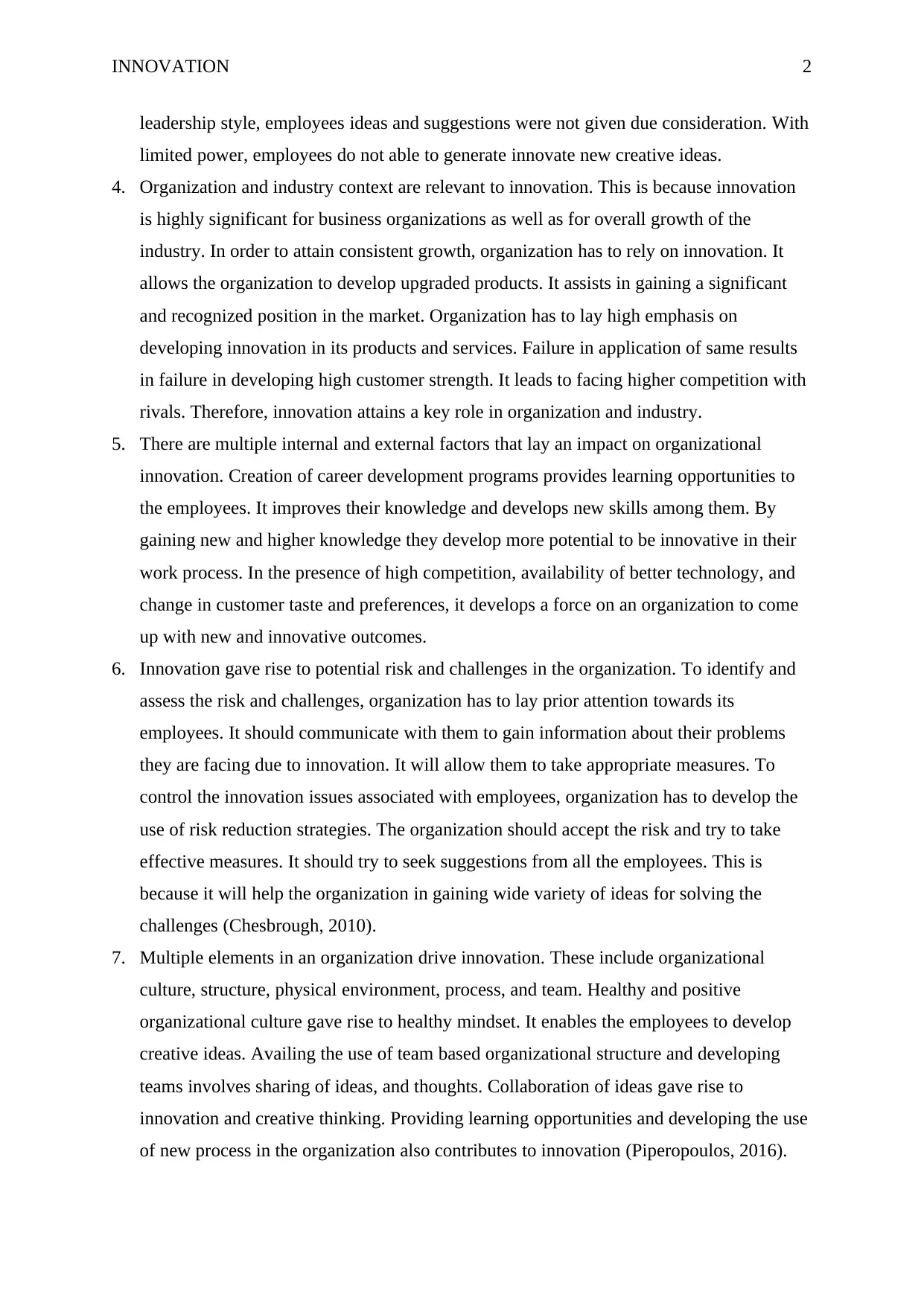
INNOVATION 2
leadership style, employees ideas and suggestions were not given due consideration. With
limited power, employees do not able to generate innovate new creative ideas.
4. Organization and industry context are relevant to innovation. This is because innovation
is highly significant for business organizations as well as for overall growth of the
industry. In order to attain consistent growth, organization has to rely on innovation. It
allows the organization to develop upgraded products. It assists in gaining a significant
and recognized position in the market. Organization has to lay high emphasis on
developing innovation in its products and services. Failure in application of same results
in failure in developing high customer strength. It leads to facing higher competition with
rivals. Therefore, innovation attains a key role in organization and industry.
5. There are multiple internal and external factors that lay an impact on organizational
innovation. Creation of career development programs provides learning opportunities to
the employees. It improves their knowledge and develops new skills among them. By
gaining new and higher knowledge they develop more potential to be innovative in their
work process. In the presence of high competition, availability of better technology, and
change in customer taste and preferences, it develops a force on an organization to come
up with new and innovative outcomes.
6. Innovation gave rise to potential risk and challenges in the organization. To identify and
assess the risk and challenges, organization has to lay prior attention towards its
employees. It should communicate with them to gain information about their problems
they are facing due to innovation. It will allow them to take appropriate measures. To
control the innovation issues associated with employees, organization has to develop the
use of risk reduction strategies. The organization should accept the risk and try to take
effective measures. It should try to seek suggestions from all the employees. This is
because it will help the organization in gaining wide variety of ideas for solving the
challenges (Chesbrough, 2010).
7. Multiple elements in an organization drive innovation. These include organizational
culture, structure, physical environment, process, and team. Healthy and positive
organizational culture gave rise to healthy mindset. It enables the employees to develop
creative ideas. Availing the use of team based organizational structure and developing
teams involves sharing of ideas, and thoughts. Collaboration of ideas gave rise to
innovation and creative thinking. Providing learning opportunities and developing the use
of new process in the organization also contributes to innovation (Piperopoulos, 2016).
leadership style, employees ideas and suggestions were not given due consideration. With
limited power, employees do not able to generate innovate new creative ideas.
4. Organization and industry context are relevant to innovation. This is because innovation
is highly significant for business organizations as well as for overall growth of the
industry. In order to attain consistent growth, organization has to rely on innovation. It
allows the organization to develop upgraded products. It assists in gaining a significant
and recognized position in the market. Organization has to lay high emphasis on
developing innovation in its products and services. Failure in application of same results
in failure in developing high customer strength. It leads to facing higher competition with
rivals. Therefore, innovation attains a key role in organization and industry.
5. There are multiple internal and external factors that lay an impact on organizational
innovation. Creation of career development programs provides learning opportunities to
the employees. It improves their knowledge and develops new skills among them. By
gaining new and higher knowledge they develop more potential to be innovative in their
work process. In the presence of high competition, availability of better technology, and
change in customer taste and preferences, it develops a force on an organization to come
up with new and innovative outcomes.
6. Innovation gave rise to potential risk and challenges in the organization. To identify and
assess the risk and challenges, organization has to lay prior attention towards its
employees. It should communicate with them to gain information about their problems
they are facing due to innovation. It will allow them to take appropriate measures. To
control the innovation issues associated with employees, organization has to develop the
use of risk reduction strategies. The organization should accept the risk and try to take
effective measures. It should try to seek suggestions from all the employees. This is
because it will help the organization in gaining wide variety of ideas for solving the
challenges (Chesbrough, 2010).
7. Multiple elements in an organization drive innovation. These include organizational
culture, structure, physical environment, process, and team. Healthy and positive
organizational culture gave rise to healthy mindset. It enables the employees to develop
creative ideas. Availing the use of team based organizational structure and developing
teams involves sharing of ideas, and thoughts. Collaboration of ideas gave rise to
innovation and creative thinking. Providing learning opportunities and developing the use
of new process in the organization also contributes to innovation (Piperopoulos, 2016).
⊘ This is a preview!⊘
Do you want full access?
Subscribe today to unlock all pages.

Trusted by 1+ million students worldwide
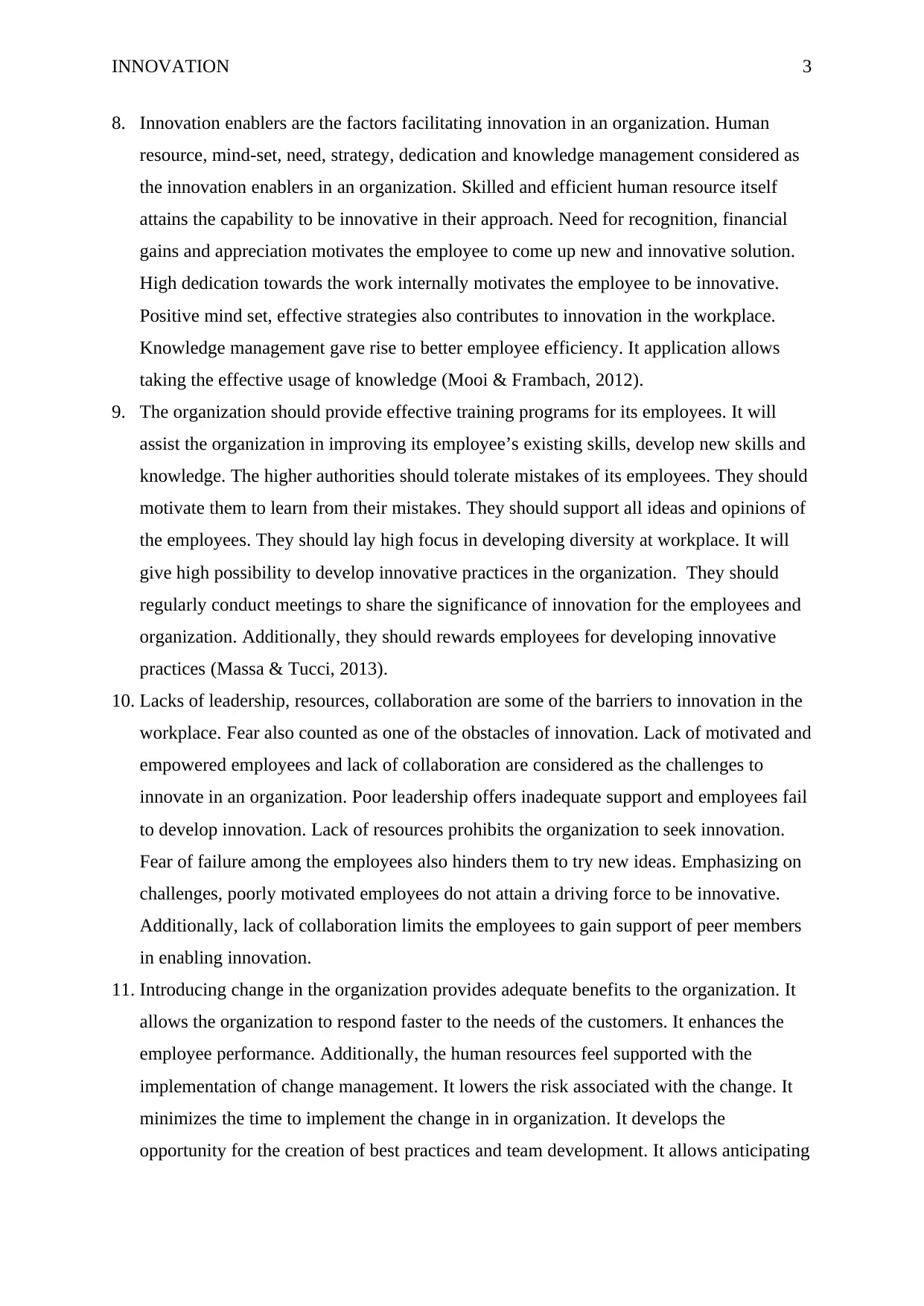
INNOVATION 3
8. Innovation enablers are the factors facilitating innovation in an organization. Human
resource, mind-set, need, strategy, dedication and knowledge management considered as
the innovation enablers in an organization. Skilled and efficient human resource itself
attains the capability to be innovative in their approach. Need for recognition, financial
gains and appreciation motivates the employee to come up new and innovative solution.
High dedication towards the work internally motivates the employee to be innovative.
Positive mind set, effective strategies also contributes to innovation in the workplace.
Knowledge management gave rise to better employee efficiency. It application allows
taking the effective usage of knowledge (Mooi & Frambach, 2012).
9. The organization should provide effective training programs for its employees. It will
assist the organization in improving its employee’s existing skills, develop new skills and
knowledge. The higher authorities should tolerate mistakes of its employees. They should
motivate them to learn from their mistakes. They should support all ideas and opinions of
the employees. They should lay high focus in developing diversity at workplace. It will
give high possibility to develop innovative practices in the organization. They should
regularly conduct meetings to share the significance of innovation for the employees and
organization. Additionally, they should rewards employees for developing innovative
practices (Massa & Tucci, 2013).
10. Lacks of leadership, resources, collaboration are some of the barriers to innovation in the
workplace. Fear also counted as one of the obstacles of innovation. Lack of motivated and
empowered employees and lack of collaboration are considered as the challenges to
innovate in an organization. Poor leadership offers inadequate support and employees fail
to develop innovation. Lack of resources prohibits the organization to seek innovation.
Fear of failure among the employees also hinders them to try new ideas. Emphasizing on
challenges, poorly motivated employees do not attain a driving force to be innovative.
Additionally, lack of collaboration limits the employees to gain support of peer members
in enabling innovation.
11. Introducing change in the organization provides adequate benefits to the organization. It
allows the organization to respond faster to the needs of the customers. It enhances the
employee performance. Additionally, the human resources feel supported with the
implementation of change management. It lowers the risk associated with the change. It
minimizes the time to implement the change in in organization. It develops the
opportunity for the creation of best practices and team development. It allows anticipating
8. Innovation enablers are the factors facilitating innovation in an organization. Human
resource, mind-set, need, strategy, dedication and knowledge management considered as
the innovation enablers in an organization. Skilled and efficient human resource itself
attains the capability to be innovative in their approach. Need for recognition, financial
gains and appreciation motivates the employee to come up new and innovative solution.
High dedication towards the work internally motivates the employee to be innovative.
Positive mind set, effective strategies also contributes to innovation in the workplace.
Knowledge management gave rise to better employee efficiency. It application allows
taking the effective usage of knowledge (Mooi & Frambach, 2012).
9. The organization should provide effective training programs for its employees. It will
assist the organization in improving its employee’s existing skills, develop new skills and
knowledge. The higher authorities should tolerate mistakes of its employees. They should
motivate them to learn from their mistakes. They should support all ideas and opinions of
the employees. They should lay high focus in developing diversity at workplace. It will
give high possibility to develop innovative practices in the organization. They should
regularly conduct meetings to share the significance of innovation for the employees and
organization. Additionally, they should rewards employees for developing innovative
practices (Massa & Tucci, 2013).
10. Lacks of leadership, resources, collaboration are some of the barriers to innovation in the
workplace. Fear also counted as one of the obstacles of innovation. Lack of motivated and
empowered employees and lack of collaboration are considered as the challenges to
innovate in an organization. Poor leadership offers inadequate support and employees fail
to develop innovation. Lack of resources prohibits the organization to seek innovation.
Fear of failure among the employees also hinders them to try new ideas. Emphasizing on
challenges, poorly motivated employees do not attain a driving force to be innovative.
Additionally, lack of collaboration limits the employees to gain support of peer members
in enabling innovation.
11. Introducing change in the organization provides adequate benefits to the organization. It
allows the organization to respond faster to the needs of the customers. It enhances the
employee performance. Additionally, the human resources feel supported with the
implementation of change management. It lowers the risk associated with the change. It
minimizes the time to implement the change in in organization. It develops the
opportunity for the creation of best practices and team development. It allows anticipating
Paraphrase This Document
Need a fresh take? Get an instant paraphrase of this document with our AI Paraphraser
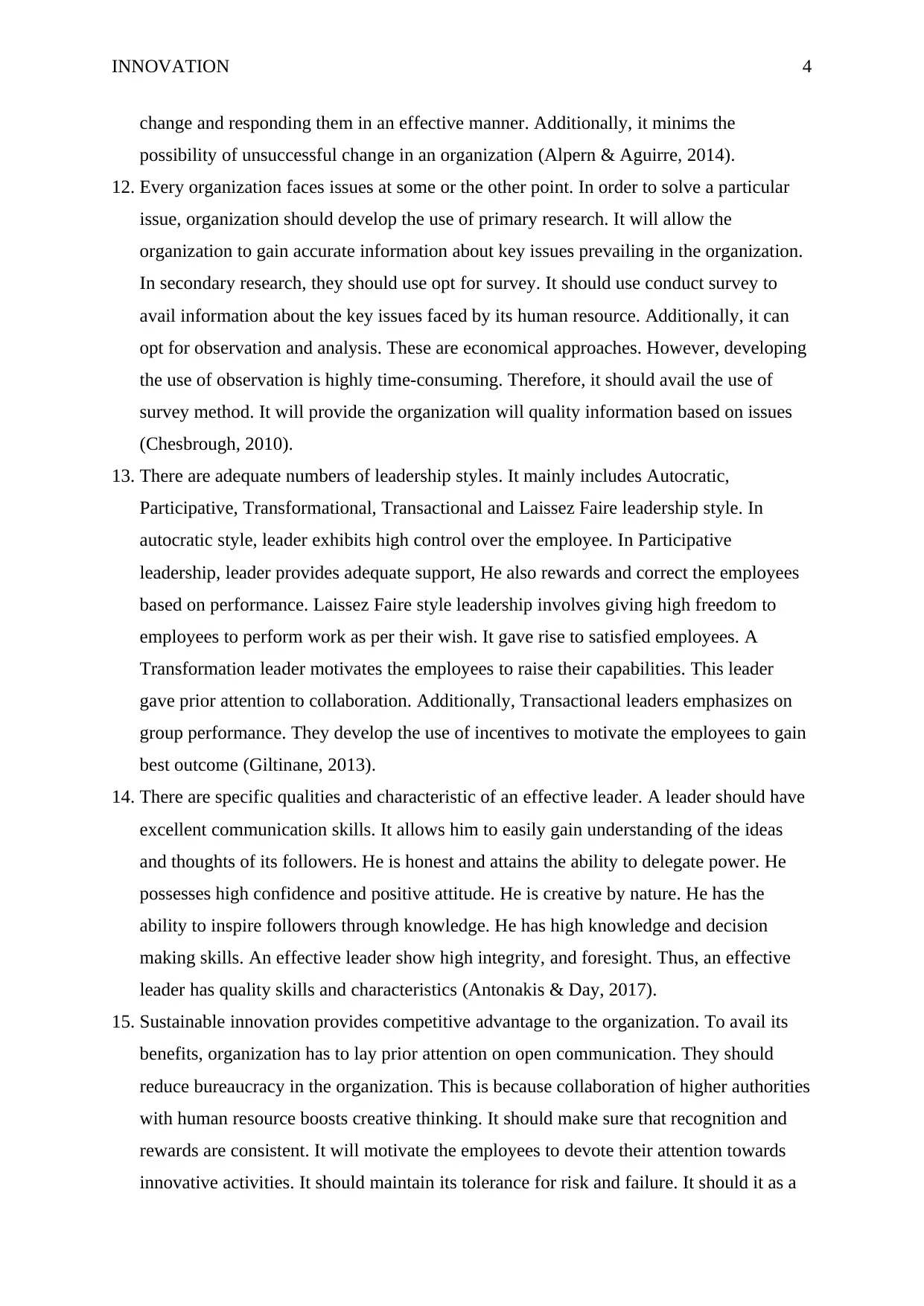
INNOVATION 4
change and responding them in an effective manner. Additionally, it minims the
possibility of unsuccessful change in an organization (Alpern & Aguirre, 2014).
12. Every organization faces issues at some or the other point. In order to solve a particular
issue, organization should develop the use of primary research. It will allow the
organization to gain accurate information about key issues prevailing in the organization.
In secondary research, they should use opt for survey. It should use conduct survey to
avail information about the key issues faced by its human resource. Additionally, it can
opt for observation and analysis. These are economical approaches. However, developing
the use of observation is highly time-consuming. Therefore, it should avail the use of
survey method. It will provide the organization will quality information based on issues
(Chesbrough, 2010).
13. There are adequate numbers of leadership styles. It mainly includes Autocratic,
Participative, Transformational, Transactional and Laissez Faire leadership style. In
autocratic style, leader exhibits high control over the employee. In Participative
leadership, leader provides adequate support, He also rewards and correct the employees
based on performance. Laissez Faire style leadership involves giving high freedom to
employees to perform work as per their wish. It gave rise to satisfied employees. A
Transformation leader motivates the employees to raise their capabilities. This leader
gave prior attention to collaboration. Additionally, Transactional leaders emphasizes on
group performance. They develop the use of incentives to motivate the employees to gain
best outcome (Giltinane, 2013).
14. There are specific qualities and characteristic of an effective leader. A leader should have
excellent communication skills. It allows him to easily gain understanding of the ideas
and thoughts of its followers. He is honest and attains the ability to delegate power. He
possesses high confidence and positive attitude. He is creative by nature. He has the
ability to inspire followers through knowledge. He has high knowledge and decision
making skills. An effective leader show high integrity, and foresight. Thus, an effective
leader has quality skills and characteristics (Antonakis & Day, 2017).
15. Sustainable innovation provides competitive advantage to the organization. To avail its
benefits, organization has to lay prior attention on open communication. They should
reduce bureaucracy in the organization. This is because collaboration of higher authorities
with human resource boosts creative thinking. It should make sure that recognition and
rewards are consistent. It will motivate the employees to devote their attention towards
innovative activities. It should maintain its tolerance for risk and failure. It should it as a
change and responding them in an effective manner. Additionally, it minims the
possibility of unsuccessful change in an organization (Alpern & Aguirre, 2014).
12. Every organization faces issues at some or the other point. In order to solve a particular
issue, organization should develop the use of primary research. It will allow the
organization to gain accurate information about key issues prevailing in the organization.
In secondary research, they should use opt for survey. It should use conduct survey to
avail information about the key issues faced by its human resource. Additionally, it can
opt for observation and analysis. These are economical approaches. However, developing
the use of observation is highly time-consuming. Therefore, it should avail the use of
survey method. It will provide the organization will quality information based on issues
(Chesbrough, 2010).
13. There are adequate numbers of leadership styles. It mainly includes Autocratic,
Participative, Transformational, Transactional and Laissez Faire leadership style. In
autocratic style, leader exhibits high control over the employee. In Participative
leadership, leader provides adequate support, He also rewards and correct the employees
based on performance. Laissez Faire style leadership involves giving high freedom to
employees to perform work as per their wish. It gave rise to satisfied employees. A
Transformation leader motivates the employees to raise their capabilities. This leader
gave prior attention to collaboration. Additionally, Transactional leaders emphasizes on
group performance. They develop the use of incentives to motivate the employees to gain
best outcome (Giltinane, 2013).
14. There are specific qualities and characteristic of an effective leader. A leader should have
excellent communication skills. It allows him to easily gain understanding of the ideas
and thoughts of its followers. He is honest and attains the ability to delegate power. He
possesses high confidence and positive attitude. He is creative by nature. He has the
ability to inspire followers through knowledge. He has high knowledge and decision
making skills. An effective leader show high integrity, and foresight. Thus, an effective
leader has quality skills and characteristics (Antonakis & Day, 2017).
15. Sustainable innovation provides competitive advantage to the organization. To avail its
benefits, organization has to lay prior attention on open communication. They should
reduce bureaucracy in the organization. This is because collaboration of higher authorities
with human resource boosts creative thinking. It should make sure that recognition and
rewards are consistent. It will motivate the employees to devote their attention towards
innovative activities. It should maintain its tolerance for risk and failure. It should it as a
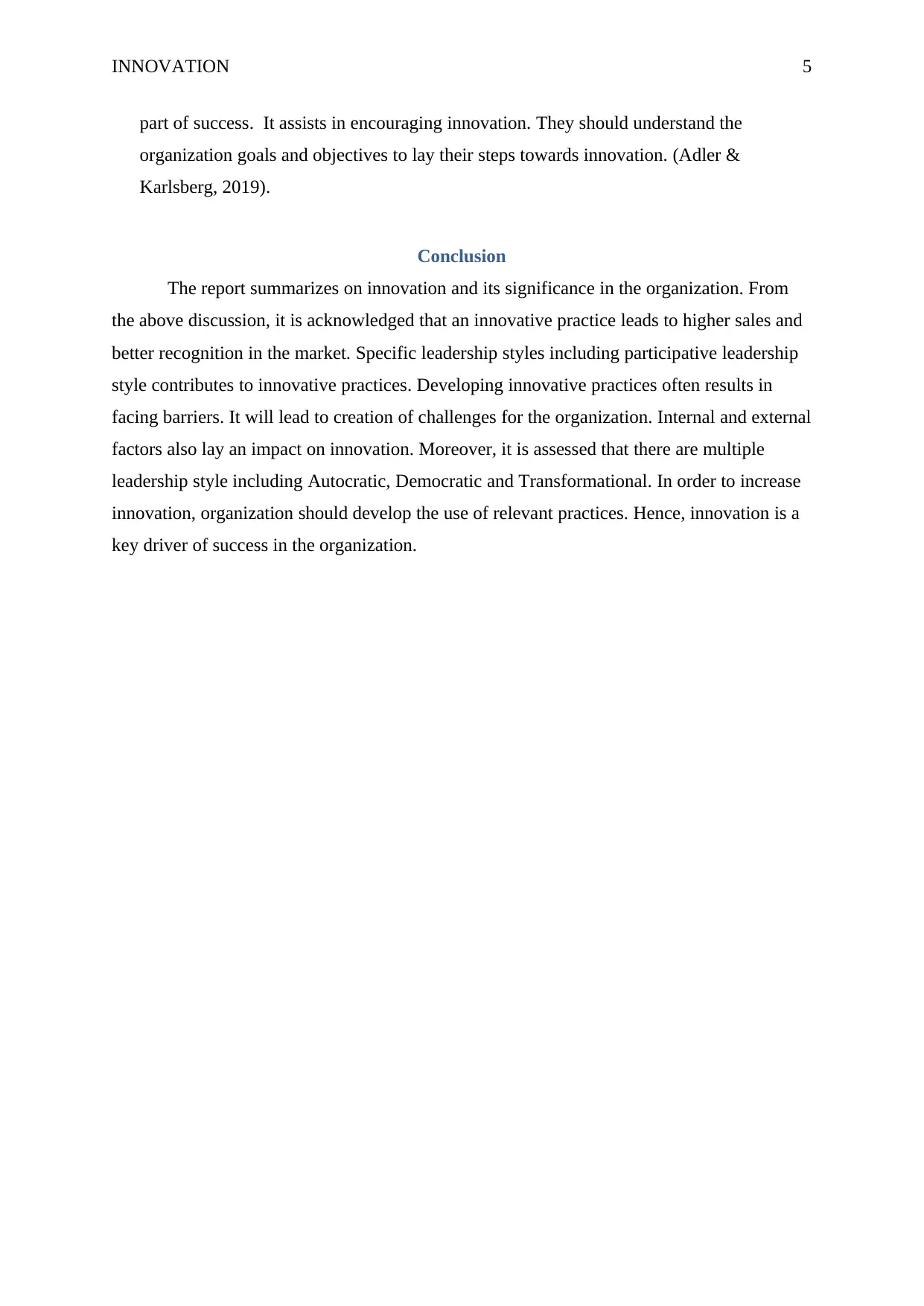
INNOVATION 5
part of success. It assists in encouraging innovation. They should understand the
organization goals and objectives to lay their steps towards innovation. (Adler &
Karlsberg, 2019).
Conclusion
The report summarizes on innovation and its significance in the organization. From
the above discussion, it is acknowledged that an innovative practice leads to higher sales and
better recognition in the market. Specific leadership styles including participative leadership
style contributes to innovative practices. Developing innovative practices often results in
facing barriers. It will lead to creation of challenges for the organization. Internal and external
factors also lay an impact on innovation. Moreover, it is assessed that there are multiple
leadership style including Autocratic, Democratic and Transformational. In order to increase
innovation, organization should develop the use of relevant practices. Hence, innovation is a
key driver of success in the organization.
part of success. It assists in encouraging innovation. They should understand the
organization goals and objectives to lay their steps towards innovation. (Adler &
Karlsberg, 2019).
Conclusion
The report summarizes on innovation and its significance in the organization. From
the above discussion, it is acknowledged that an innovative practice leads to higher sales and
better recognition in the market. Specific leadership styles including participative leadership
style contributes to innovative practices. Developing innovative practices often results in
facing barriers. It will lead to creation of challenges for the organization. Internal and external
factors also lay an impact on innovation. Moreover, it is assessed that there are multiple
leadership style including Autocratic, Democratic and Transformational. In order to increase
innovation, organization should develop the use of relevant practices. Hence, innovation is a
key driver of success in the organization.
⊘ This is a preview!⊘
Do you want full access?
Subscribe today to unlock all pages.

Trusted by 1+ million students worldwide
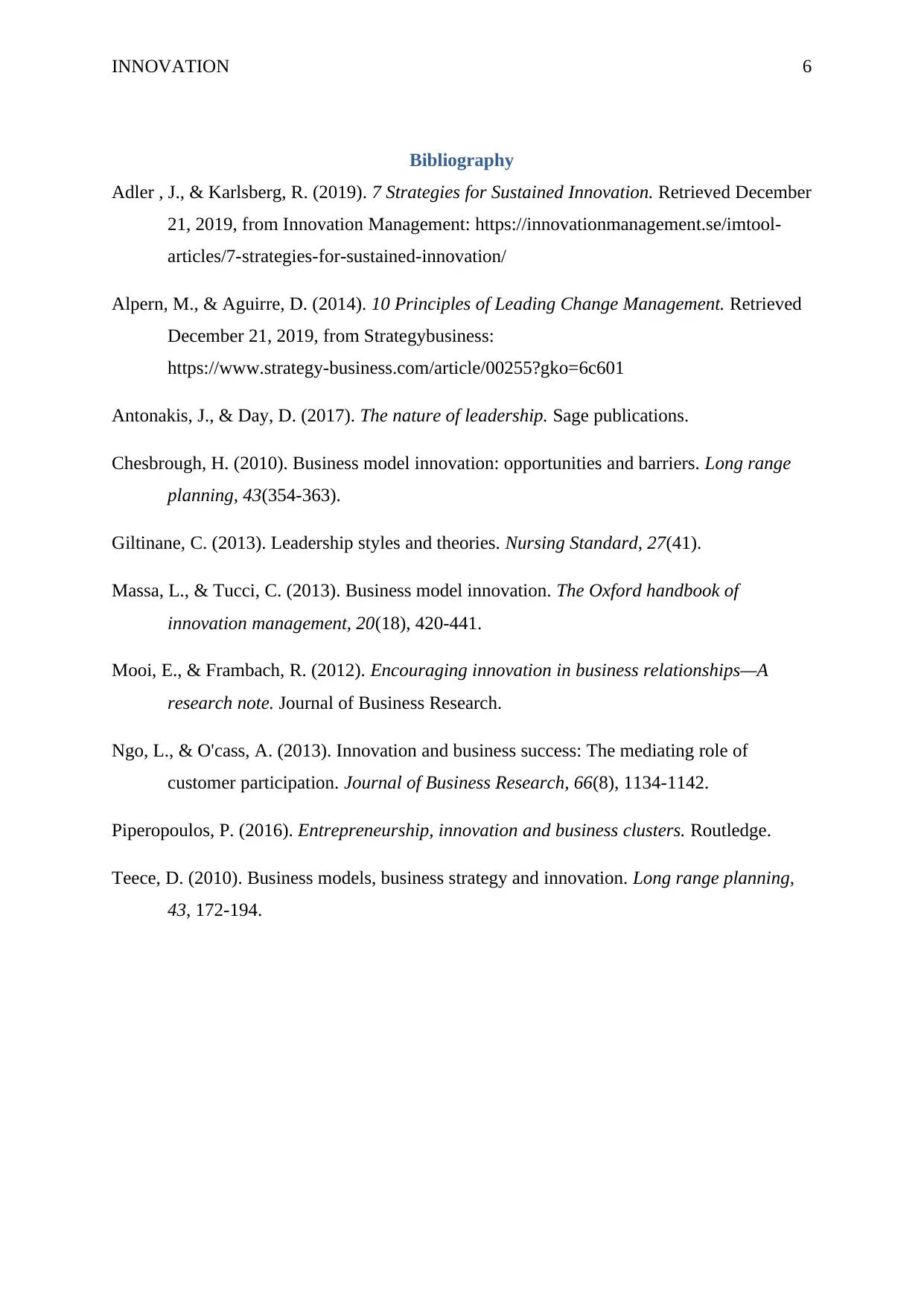
INNOVATION 6
Bibliography
Adler , J., & Karlsberg, R. (2019). 7 Strategies for Sustained Innovation. Retrieved December
21, 2019, from Innovation Management: https://innovationmanagement.se/imtool-
articles/7-strategies-for-sustained-innovation/
Alpern, M., & Aguirre, D. (2014). 10 Principles of Leading Change Management. Retrieved
December 21, 2019, from Strategybusiness:
https://www.strategy-business.com/article/00255?gko=6c601
Antonakis, J., & Day, D. (2017). The nature of leadership. Sage publications.
Chesbrough, H. (2010). Business model innovation: opportunities and barriers. Long range
planning, 43(354-363).
Giltinane, C. (2013). Leadership styles and theories. Nursing Standard, 27(41).
Massa, L., & Tucci, C. (2013). Business model innovation. The Oxford handbook of
innovation management, 20(18), 420-441.
Mooi, E., & Frambach, R. (2012). Encouraging innovation in business relationships—A
research note. Journal of Business Research.
Ngo, L., & O'cass, A. (2013). Innovation and business success: The mediating role of
customer participation. Journal of Business Research, 66(8), 1134-1142.
Piperopoulos, P. (2016). Entrepreneurship, innovation and business clusters. Routledge.
Teece, D. (2010). Business models, business strategy and innovation. Long range planning,
43, 172-194.
Bibliography
Adler , J., & Karlsberg, R. (2019). 7 Strategies for Sustained Innovation. Retrieved December
21, 2019, from Innovation Management: https://innovationmanagement.se/imtool-
articles/7-strategies-for-sustained-innovation/
Alpern, M., & Aguirre, D. (2014). 10 Principles of Leading Change Management. Retrieved
December 21, 2019, from Strategybusiness:
https://www.strategy-business.com/article/00255?gko=6c601
Antonakis, J., & Day, D. (2017). The nature of leadership. Sage publications.
Chesbrough, H. (2010). Business model innovation: opportunities and barriers. Long range
planning, 43(354-363).
Giltinane, C. (2013). Leadership styles and theories. Nursing Standard, 27(41).
Massa, L., & Tucci, C. (2013). Business model innovation. The Oxford handbook of
innovation management, 20(18), 420-441.
Mooi, E., & Frambach, R. (2012). Encouraging innovation in business relationships—A
research note. Journal of Business Research.
Ngo, L., & O'cass, A. (2013). Innovation and business success: The mediating role of
customer participation. Journal of Business Research, 66(8), 1134-1142.
Piperopoulos, P. (2016). Entrepreneurship, innovation and business clusters. Routledge.
Teece, D. (2010). Business models, business strategy and innovation. Long range planning,
43, 172-194.
1 out of 7
Related Documents
Your All-in-One AI-Powered Toolkit for Academic Success.
+13062052269
info@desklib.com
Available 24*7 on WhatsApp / Email
![[object Object]](/_next/static/media/star-bottom.7253800d.svg)
Unlock your academic potential
Copyright © 2020–2025 A2Z Services. All Rights Reserved. Developed and managed by ZUCOL.





